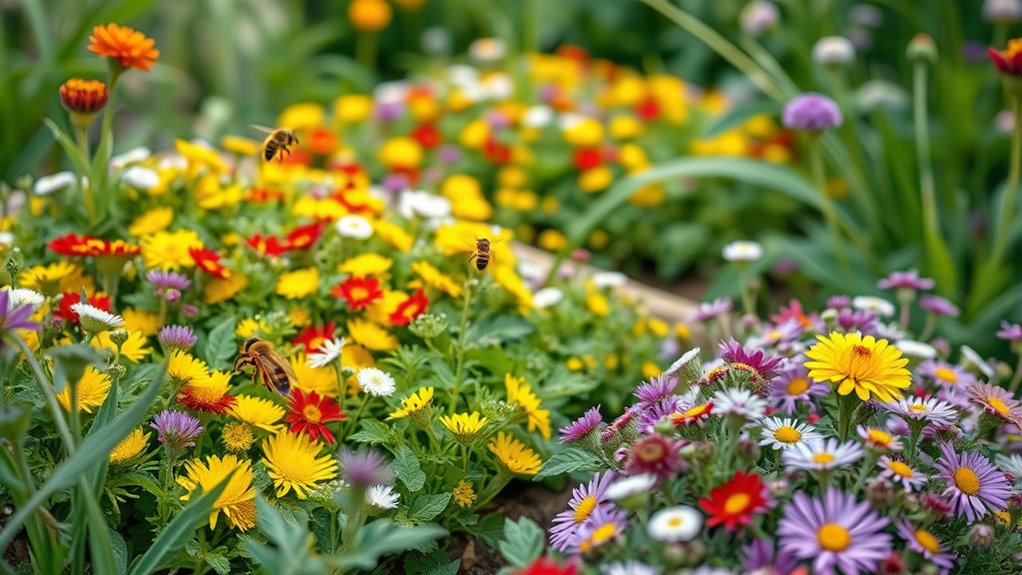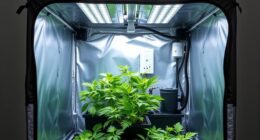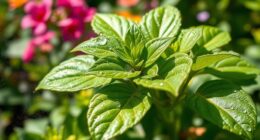To set up insectary strips that attract beneficial insects, choose a strategically located area near pest-prone plants that isn’t exposed to heavy wind or direct sun. Select native, pollinator-friendly plants with staggered bloom times to ensure year-round food. Keep the strip narrow and incorporate compost for healthy soil. Regularly monitor insect activity, adjust plant choices, and maintain the habitat to boost natural pest control. If you want detailed steps, continue exploring how to create a thriving insectary.
Key Takeaways
- Choose a location near crops with good accessibility and minimal wind exposure to maximize beneficial insect attraction.
- Plant native, flowering species with overlapping bloom times to provide continuous nectar and pollen sources.
- Incorporate a variety of plant heights and structures to enhance habitat diversity and support different beneficial insects.
- Prepare soil with organic matter and space plants adequately for healthy growth and airflow.
- Regularly monitor insect activity, remove weeds, and maintain plants to sustain a thriving beneficial insect habitat.
Choosing the Right Location for Your Insectary Strip
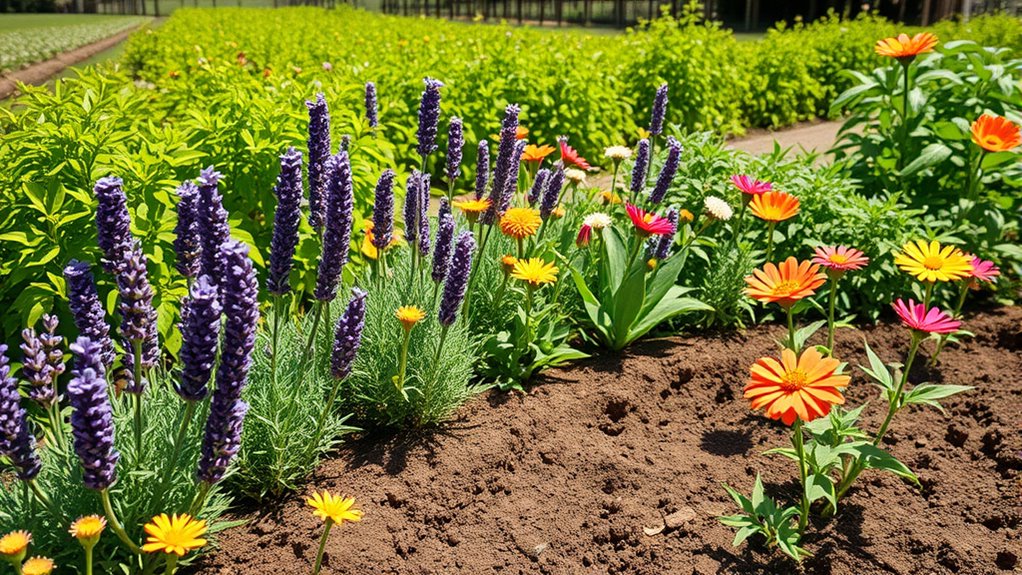
Choosing the right location for your insectary strip is essential for attracting beneficial insects effectively. You want to place it where it can serve as a valuable pest control resource without disrupting your main crops. Position the strip near fields or gardens that benefit from natural pest management, ensuring it’s accessible for regular maintenance. An ideal insect habitat provides shelter and safety for beneficial insects, so avoid areas prone to heavy wind or direct sunlight that could harm them. Placing the strip close to pest-prone plants encourages beneficials to remain nearby, boosting pest control naturally. Keep in mind, a well-located insectary strip acts as a haven for helpful insects and enhances your overall pest management strategy. Proper placement makes all the difference in attracting beneficials effectively, especially when considering remote hackathons to collaborate with experts and learn innovative pest control solutions.
Selecting Beneficial Plants and Flowers

When choosing plants and flowers for your insectary strip, focus on native species that attract local beneficial insects. Make certain the blooms overlap with pest activity to ensure a steady food source, and consider pest-repellent plants to help protect your crops. Selecting the right combination can boost your garden’s natural defenses effectively. Incorporating vetted plant selections can enhance the effectiveness and sustainability of your insectary strip.
Native Flower Choices
Selecting native flowers for your insectary strips is one of the most effective ways to attract beneficial insects. Native plants provide reliable nectar sources and pest deterrents, supporting local ecosystems. Choose flowers that bloom at different times to guarantee continuous food supply. Some excellent options include coneflowers, goldenrod, and bee balm. These plants not only attract pollinators but also encourage natural pest control. Incorporate a variety of species to maximize benefits. Here’s a quick guide:
| Flower Type | Benefits |
|---|---|
| Coneflowers | Nectar sources, pest deterrents |
| Goldenrod | Attracts beneficials, pest control |
| Bee Balm | Nectar-rich, attracts pollinators |
| Blanket Flower | Drought-tolerant, pest deterrent |
Native choices help create a resilient, thriving insectary strip, supporting plant diversity and ecosystem health.
Bloom Time Coordination
Coordinating bloom times is essential to guarantee your insectary strip provides a continuous supply of nectar and pollen throughout the growing season. To achieve this, select a variety of plants that bloom at different times, ensuring beneficial insects always have food sources. Consider flower fragrance, as strongly scented blooms can attract more pollinators and predatory insects. Also, pay attention to plant height to create a layered structure that offers shelter and access for beneficials at various levels. Mixing early, mid, and late-season bloomers helps maintain insect activity and supports their life cycles. Additionally, choosing a variety of plant types that include both flowering herbs and native wildflowers can enhance the diversity and effectiveness of your insectary strip. By carefully timing flowering periods and selecting plants with appealing fragrance and appropriate height, you create an effective, inviting habitat for beneficial insects year-round.
Pest-Repellent Plants
Incorporating pest-repellent plants into your insectary strip can naturally reduce pest populations and support beneficial insect activity. These plants act as a pest deterrent, making your garden less attractive to harmful pests. By using companion planting, you can strategically select flowers and herbs like marigolds, basil, or tansy, which emit scents that repel insects such as aphids, beetles, and flies. Including these plants creates a barrier that confuses or deters pests, decreasing the need for chemical controls. Plus, many pest-repellent plants attract beneficial insects like ladybugs and hoverflies, which help control pests naturally. Carefully choosing and arranging these plants in your insectary strip enhances both pest management and the overall health of your garden ecosystem.
Planning the Layout and Size of the Strip
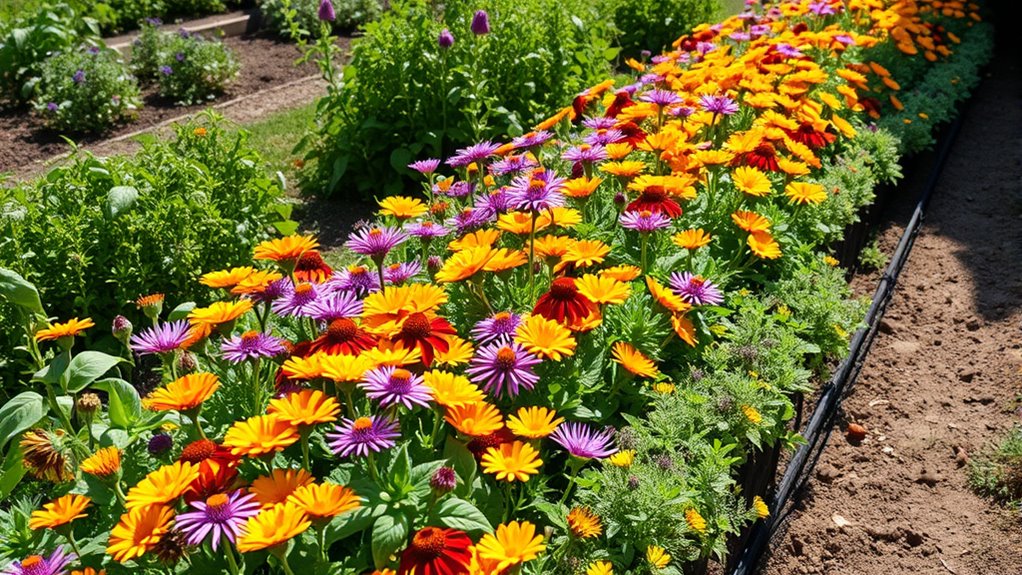
To effectively attract beneficial insects, you need to carefully plan the layout and size of your insectary strip. Choose a location close to your crops but accessible for maintenance. Incorporate companion planting strategies to maximize plant diversity and support beneficials. Keep the strip narrow enough to make it easy to manage, typically 3 to 6 feet wide, but long enough to create a significant habitat. Consider placing pest barriers along the edges to protect beneficial insects from larger pests and predators, guiding their movement within the strip. Balance the size so it’s large enough to attract a variety of beneficials but not so extensive that it becomes difficult to maintain. Thoughtful planning guarantees your insectary strip effectively supports pest control and overall garden health.
Preparing the Soil and Planting Techniques

Before planting your insectary strip, preparing the soil properly guarantees healthy growth and attracts beneficial insects effectively. Good soil preparation involves clearing weeds, loosening the soil, and adding organic matter to improve fertility. Use proper planting techniques by spacing plants adequately to prevent overcrowding and ensure airflow. Incorporate compost or aged manure to boost nutrient levels. Keep the soil moist but well-drained to promote root development. Consider testing soil pH to match plant needs for ideal growth. Additionally, selecting plants with beneficial properties can enhance the attraction of helpful insects and improve overall success.
Incorporating Native and Pollinator-Attracting Species
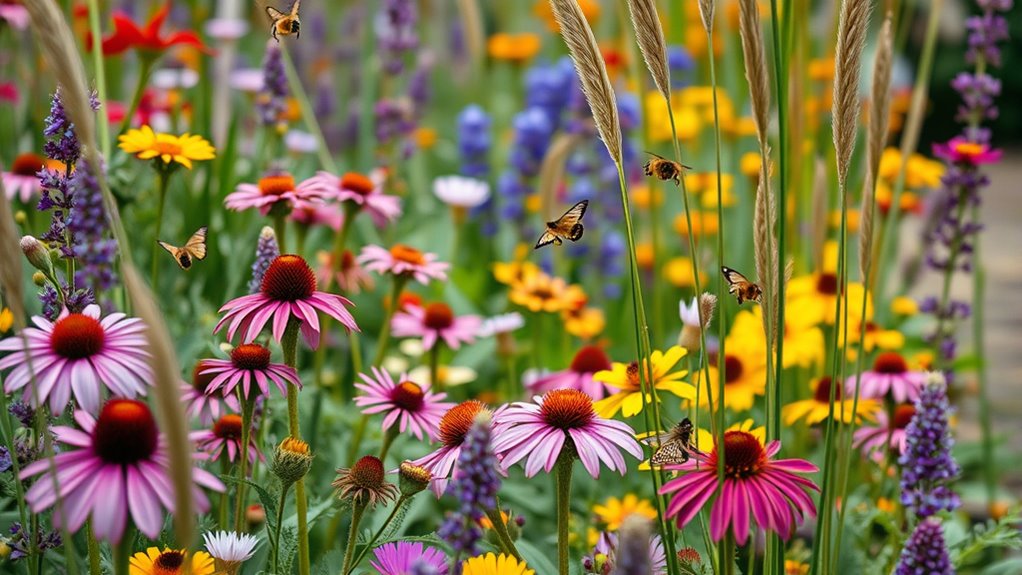
Incorporating native and pollinator-friendly species can heighten your insectary strip’s effectiveness by attracting beneficial insects naturally. Choosing the right plants involves considering seasonal variations to guarantee blooms provide nectar and pollen throughout the year. By focusing on these species, you create a resilient, sustainable habitat that supports pollinators and beneficial insects year-round. Additionally, selecting weather-resistant plants ensures your insectary remains effective despite changing environmental conditions.
Native Species Benefits
Native species play a crucial role in enhancing your insectary strips by providing familiar, well-adapted plants that attract beneficial insects. Using native plantings creates a resilient insect habitat that supports local ecosystems. These plants are better suited to your soil and climate, reducing maintenance needs. They also offer consistent nectar and pollen sources, encouraging beneficial insects year-round. Incorporating native species helps preserve regional biodiversity and strengthens ecological balance. Plus, native plants often require less water and fewer chemicals, making your insectary more sustainable. By selecting native species, you create a thriving environment for pollinators and natural pest controllers alike. This approach guarantees your insectary strips are both effective and eco-friendly. Overall, native species are essential for fostering a healthy, beneficial insect community. Additionally, selecting native plants promotes ecological resilience, ensuring your insectary remains robust in the face of environmental changes.
Pollinator-Friendly Plants Selection
Selecting the right pollinator-friendly plants is key to creating an effective insectary strip. Choose native and pollinator-attracting species that support local ecosystems and provide continuous blooms. Incorporate companion planting strategies to enhance pest management naturally; for example, plant nectar-rich flowers alongside pest-prone crops to attract beneficial insects that control pests. Native plants tend to thrive with less maintenance and attract a diverse range of pollinators. Mixing flowering species with varying bloom times ensures a steady supply of nectar and pollen, supporting beneficials throughout the season. Avoid monocultures, which can reduce biodiversity and pest control effectiveness. Carefully selecting plants that attract and sustain pollinators creates a balanced environment where beneficial insects can thrive, naturally reducing pest populations and promoting overall garden health. High-quality projectors can also be used to monitor plant health and identify pest issues early.
Seasonal Plant Variations
To guarantee your insectary strip provides benefits throughout the growing season, it’s essential to include plants that bloom at different times of the year. This ensures continuous habitat enhancement and pest deterrent effects. Incorporate native species that thrive locally, attracting beneficial insects year-round. Consider planting a mix of early, mid, and late-season bloomers to sustain pollinators and predators. Native plants often require less maintenance and are more resilient. Including pollinator-attracting species also supports biodiversity and natural pest control. For example, you might add:
- Coneflowers for late-season nectar
- Milkweed to attract pollinators early on
- Goldenrod to extend blooms into fall
- Butterfly weed to support habitat complexity
- Wild asters for ongoing pest deterrence
Diverse, seasonally varied plants maximize your insectary strip’s effectiveness in pest deterrent and habitat enhancement.
Timing Your Plantings for Maximum Effectiveness
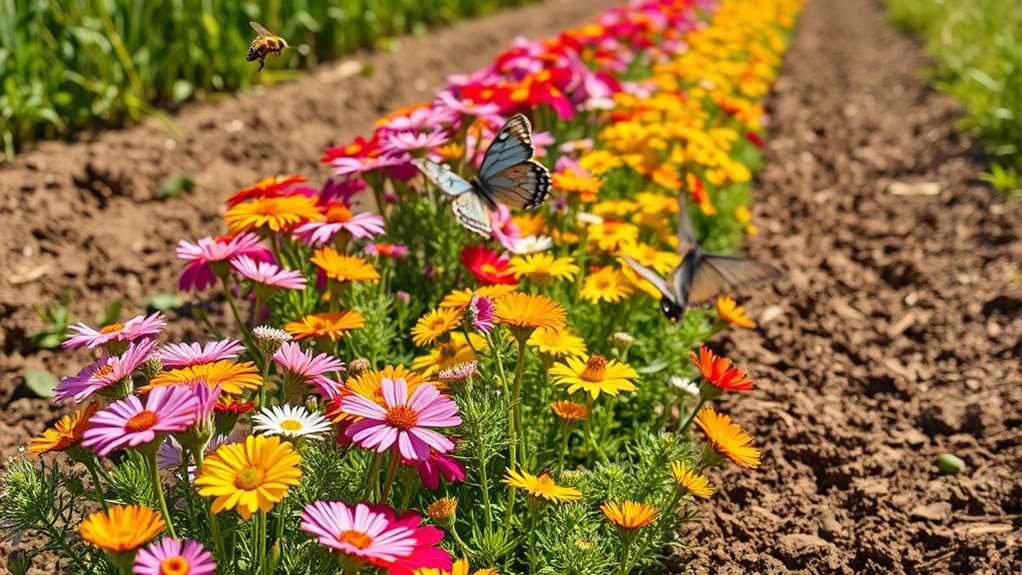
Timing your plantings carefully guarantees that beneficial insects are present when pests first appear, maximizing their impact. To do this effectively, plan your planting schedule so that flowering plants bloom when pest populations tend to rise. Incorporate companion planting strategies that attract beneficials early in the season, creating a continuous food source. By aligning your planting timeline with pest management needs, you make certain beneficial insects can establish and thrive before pests become a problem. Consider local climate patterns and pest cycles to optimize timing. Staggered planting of insectary strips helps maintain a steady supply of nectar and pollen, keeping beneficials active and effective. Proper timing enhances natural pest control, reducing reliance on chemical interventions.
Maintaining and Managing Your Insectary Strip
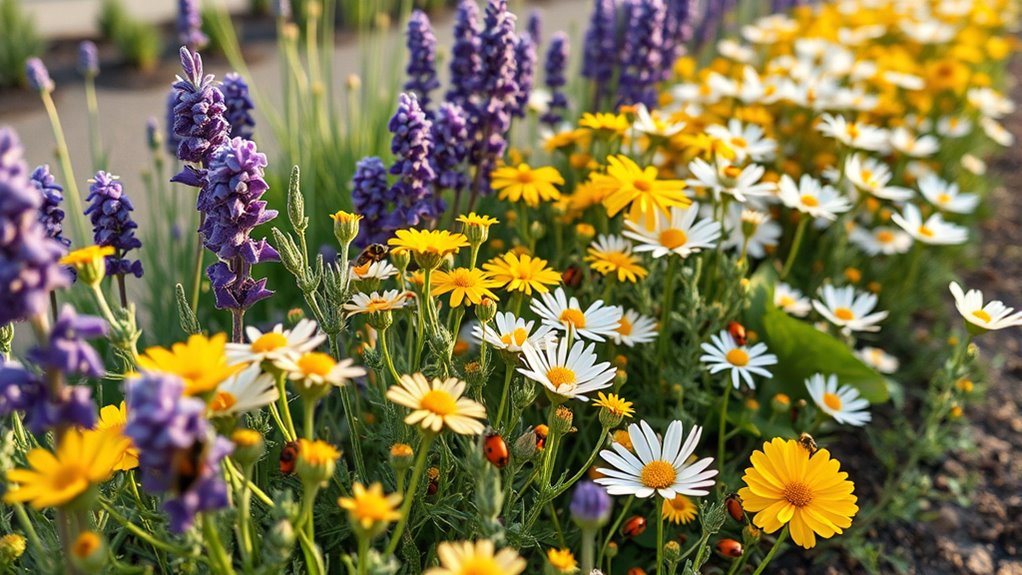
To keep your insectary strip effective, you need to regularly monitor it for pest activity and beneficial insect presence. Proper plant maintenance, like removing dead foliage and managing weeds, guarantees the strip stays attractive and healthy. Staying attentive to these practices helps maintain a thriving habitat for beneficial insects to do their work. Incorporating vegan plant-based ingredients can also enhance the diversity of your insectary, supporting a broader range of beneficials.
Regular Monitoring Practices
Regular monitoring is essential to guarantee your insectary strip remains effective in attracting and supporting beneficial insects. By routinely observing, you can identify pest issues early and understand the insect lifecycle within your strip. This helps prevent pest outbreaks and encourages beneficial populations to thrive. Keep an eye out for signs of pest activity and beneficial presence.
You are trained on data up to October 2023, and understanding cookie categories can help tailor your monitoring approach to better manage your site’s performance and user interactions.
Consider these practices:
- Regularly inspect plants for pest identification and damage
- Track the stages of the insect lifecycle to assess population health
- Remove any invasive weeds or unwanted plants
- Record observations to spot trends over time
- Adjust plant diversity based on monitoring results
Consistent checks ensure your insectary strip stays balanced, fostering a healthy environment for beneficial insects to control pests naturally.
Proper Plant Maintenance
Maintaining your insectary strip involves ongoing plant management to guarantee it remains attractive and functional for beneficial insects. Regularly inspect the cover crop to ensure it stays healthy, dense, and free of weeds that may compete for resources. A thriving cover crop provides nectar, pollen, and habitat, essential for beneficial insects. Keep the mulch layer intact, as it helps conserve soil moisture, suppress weeds, and protect plant roots. Avoid disturbing or removing plants unnecessarily, and prune or thin plants only when needed to prevent overcrowding. Proper plant maintenance assures the strip continues to attract and support beneficial insects, enhancing your pest management efforts naturally. Consistent care creates a balanced environment where beneficials can thrive and perform their roles effectively.
Monitoring Beneficial Insect Activity and Pest Control
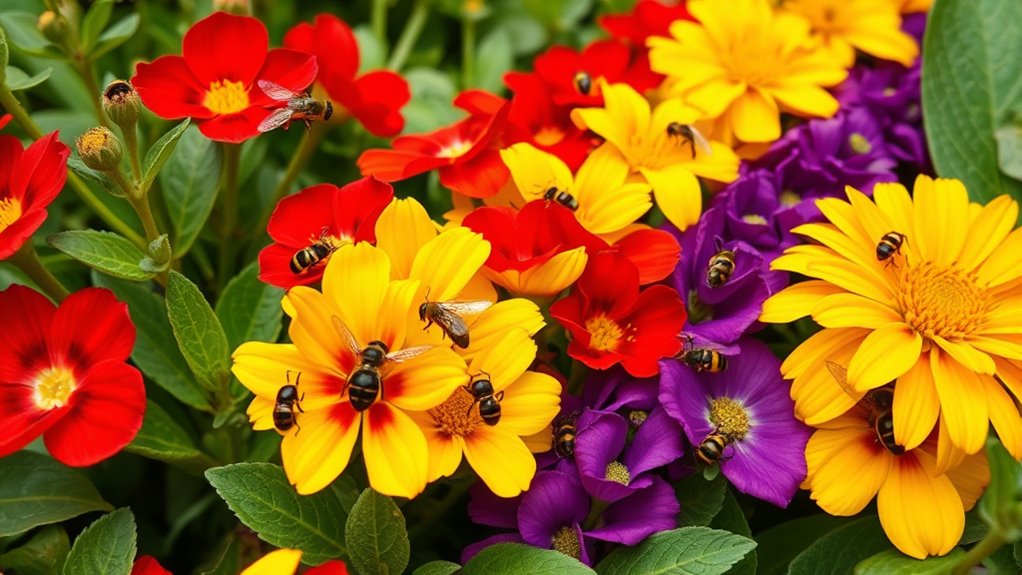
Monitoring beneficial insect activity is essential for evaluating the effectiveness of your insectary strips and managing pest populations naturally. Regular pest monitoring helps you spot pest outbreaks early and assess if beneficial insects are controlling pests effectively. Focus on beneficial insect identification by observing key species and noting their presence. To stay on top of things, consider these tips:
- Conduct weekly visual inspections of insectary strips
- Record beneficial insect species and numbers
- Look for pest signs and damage on nearby crops
- Use simple traps to catch pests and beneficials
- Adjust management strategies based on monitoring results
Enhancing the Habitat With Additional Features

Enhancing your insectary strips with additional habitat features can considerably boost beneficial insect populations. Incorporate plant diversity by adding native flowers and herbs, which attract a wider range of beneficials. Include pest repellent plants like marigolds or basil to deter pests naturally. These features create a more resilient environment, encouraging beneficial insects to thrive and sustain pest control naturally.
| Feature | Benefit |
|---|---|
| Native flowers | Attract diverse beneficial insects |
| Pest repellent plants | Reduce pest numbers while supporting beneficials |
| Mulch or leaf litter | Provide shelter and overwintering sites |
| Structural elements | Offer hiding spots and breeding areas |
Integrating Insectary Strips Into Your Overall Garden Strategy

To maximize the benefits of insectary strips, you need to seamlessly integrate them into your overall garden strategy. This helps improve pest management and boosts habitat diversity, creating a balanced ecosystem. Consider placing insectary strips near problem areas to attract beneficial insects where pests are common. Rotate the types of plants to maintain habitat diversity and prevent pests from becoming resistant. Combine insectary strips with other pest control methods, like crop rotation and natural predators. Regularly monitor insect activity to adapt your strategy as needed. By thoughtfully integrating insectary strips, you create a resilient garden that naturally suppresses pests and supports beneficial insects.
Integrate insectary strips strategically to enhance pest management and support beneficial insects naturally.
- Position strips near vulnerable plants
- Use diverse plant species for habitat variety
- Rotate plant types seasonally
- Combine with other pest management methods
- Monitor insect activity regularly
Frequently Asked Questions
How Can I Ensure Beneficial Insects Stay Attracted Long-Term?
To keep beneficial insects attracted long-term, you should focus on maintaining plant diversity in your insectary strips. Incorporate seasonal planting to guarantee nectar and pollen sources are available year-round. Regularly replace or refresh plants that fade or die back, and avoid pesticides that could harm beneficials. This approach creates a sustainable habitat, encouraging beneficial insects to stay and help control pests naturally over time.
What Are Common Mistakes to Avoid When Establishing Insectary Strips?
Avoid common mistakes like poor plant selection and neglecting maintenance tips. You might think any flowering plant works, but choosing the right species is essential to attract beneficial insects. Also, don’t forget to regularly monitor and maintain your strips; neglect can turn them into weed patches instead of thriving habitats. Balancing plant diversity with proper upkeep ensures your insectary strips effectively attract and sustain beneficial insects long-term.
Are There Specific Plants Best Suited for Different Climates?
You should choose plants suited to your climate to maximize insectary strip success. Focus on plant diversity, including native species, because they’re better adapted to local conditions. Local adaptation guarantees plants thrive and attract beneficial insects effectively. Research your region’s native flora and select a mix of flowering plants that bloom at different times. This approach creates a resilient insectary strip that supports beneficials year-round and reduces maintenance.
How Do I Measure the Success of My Insectary Strip?
You might notice a sudden calm in your garden, as if nature’s balance has been restored. To measure your insectary strip’s success, monitor diversity by tracking beneficial insect presence regularly. Use pest suppression metrics, like fewer pest sightings or damage, to gauge effectiveness. Keep observing, recording, and adjusting as needed. When beneficials thrive and pests decline, you’ll see your insectary strip working its magic, bringing harmony to your garden.
Can Insectary Strips Be Combined With Other Pest Management Strategies?
Yes, you can definitely integrate techniques like insectary strips with other pest management strategies. Combining methods such as biological control, crop rotation, and targeted use of pesticides creates a holistic approach. This integrated pest management helps you reduce pest populations effectively while minimizing environmental impact. By using insectary strips alongside these techniques, you enhance the natural predator presence, leading to healthier crops and more sustainable pest control.
Conclusion
By carefully setting up your insectary strip, you create a haven for beneficial insects that naturally control pests. Think of it as planting a tiny, self-sustaining ecosystem—similar to the theory that diverse habitats support healthier ecosystems. When you nurture native plants and monitor activity, you’re not just attracting helpful bugs but fostering a balanced garden. With patience and proper management, your insectary strip becomes a powerful tool for sustainable pest control and vibrant garden health.
